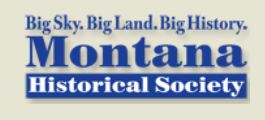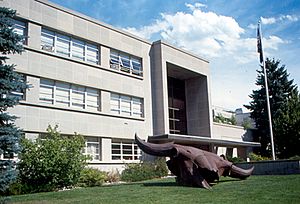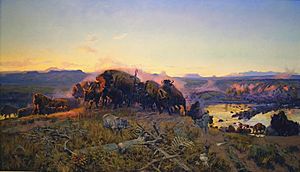Montana Historical Society facts for kids
 |
|
 The Veterans and Pioneers Memorial Building, home of the Montana Historical Society since 1953, as it appeared in 1999 |
|
| Agency overview | |
|---|---|
| Formed | February 2, 1865 |
| Jurisdiction | Montana State Government |
| Headquarters | Helena, Montana |
| Motto | Big Sky, Big Land, Big History |
| Agency executive |
|
The Montana Historical Society (MHS) is a special place in Montana. It helps keep important historical items safe. These items help us understand the amazing story of Montana. The society has different teams that work on things like research, running the museum, and teaching people about history. It is guided by a group of 15 trustees. They choose the director and make rules for the society. The MHS started in 1865, making it one of the oldest groups like it in the western United States.
Contents
The Story of the Montana Historical Society
How it Started
The Montana Historical Society began on February 2, 1865. This was just seven months after the Montana Territory was created. A man named Francis M. Thompson suggested creating the society. The idea was to gather facts about Montana's early days. They wanted to learn about how mines were found and stories from the fur trade.
Many important people helped start the society. These included Hezekiah L. Hosmer, Christopher P. Higgins, and Wilbur F. Sanders. The Montana Historical Society is the second oldest state historical society west of the Mississippi River.
Moving to Helena
The society first started in Virginia City, Montana. But in 1874, it moved to Helena, Montana. This happened after Helena was chosen as the new capital of the territory. In 1902, the society found a new home. It moved into the basement of the new Montana State Capitol building.
What the Society Collects
The Montana Historical Society has many cool things! They collect old papers and stories from people who lived long ago. These stories are called "oral histories."
Important Records
Since 1969, the society has been the official place for Montana's government records. This means they keep many important documents from the state and local governments.
Pictures and Books
They have a huge collection of over half a million old photographs. These pictures show what life was like in the 1800s and 1900s. The society also has a large library. It's filled with books, newspapers, maps, and even old music. They also have the biggest collection of newspaper clippings about Montana.
Art and Artifacts
The museum has a lot of art and historical objects. These items show all of Montana's history. They have many things that teach us about Native American culture in Montana.
Montana Historical Society Museum
The Montana Historical Society Museum is also known as Montana's Museum. It is located in Helena, Montana. You can visit the museum all year round. It shows off the state's fine art, history, and old objects.
What You Can See
One special part of the museum is the Mackay Gallery of Russell Art. It features many artworks by the famous Western artist Charles M. Russell. You can see his paintings and sculptures. Other exhibits show how Native Americans lived, what life was like for early settlers, and how people mined for gold. There are also displays of old frontier weapons and even a white bison!
Protecting Montana's History
In 2023, some historical items were taken from the Montana Historical Society. These items were very important to Montana's history. They included letters from Nancy Russell, the wife of artist C.M. Russell. The person who took them tried to sell them online and to collectors.
The person was caught trying to sell items to an undercover agent. Many of the stolen items were found and returned. However, some items are still missing. The staff at the Montana Historical Society said that these items belong to all the people of Montana. They also said that because of this event, they had to make rules stricter for people who want to study historical documents. This helps keep Montana's history safe for everyone.
Notable People Connected to the Society
- Laura E. Howey (1851-1911) - She was the Secretary and Librarian for a time.
- K. Ross Toole - He was a historian and a director of the Montana Historical Society.


